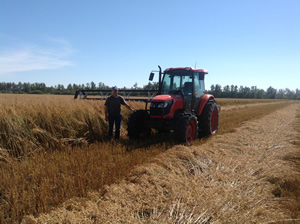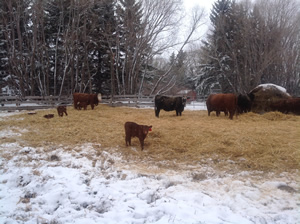The United Nations made 2015 the International Year of Soils with healthy soils being the basis for healthy food production as one of its key messages.
A key part of the organic agricultural movement started with soil building.
“Because organic farmers do not use synthetic nutrients to restore degraded soil, they must concentrate on building and maintaining soil fertility primarily through their basic farming practices,” according to the Food and Agriculture Organization of the United Nations.

Terry Sheehan shows how the wasteful nature of cattle can build topsoil on his Westlock, Alberta, farm and ranch. Grass creates an amazing amount of thatch, he said. That is like grass that eventually ends up higher than a sidewalk so you might think the sidewalk was built too low, but he said that’s grass building soil. Terry rotates his 160 base cattle herd over fields and pastures for several years where they stomp thatch into the ground and leave manure. This increases organic matter and makes soil look brown, rather than black, when he cultivates, he said.
“I know a lot of people don’t like the sound of plowing,” he said.
It is part of a multi-year, rotational pasture plan. He cultivates about 25 percent of his roughly 1,300 acres. Fields start as a hay crop, such as alfalfa, he said. Grass takes over as an alfalfa field gets old and then becomes cattle pasture. In about the seventh year, they get tore up as a seedbed for oats.

Terry’s organic practices can fetch about $1 more for his calves from buyers where demand is outpacing supply for organic products. He said the premium wasn’t there when he first certified organic with the Organic Crop Improvement Association in 1997. The reason to certify then was a health aspect or just because you thought it was the right thing to do, he said.
He said he was already thinking of certifying organic when OCIA’s Alberta 1 chapter help a meeting in a nearby town in the late 1990s. Pesticides “didn’t agree with him,” he said, after years of spraying. He suspected the 2-4-D herbicide was the top offender. He still feels sick walking across a sprayed lawn in a town, he said.
Cattle grazing on his crop ground cleaned the land enough he didn’t have to spray it and that made his transition to organic certification easier. People involved in the OCIA Alberta 1 chapter at the time mentored him, too.
Nearly two decades later, Terry mentors new and potential farmers as a founding board member of the OCIA Chapter Members Association Canada – along with Kevin Gingras, Cherylynn Bos and Marg Laberge. It’s a new chapter in Canada that assists members from any province with low-cost mentorship. The chapter will have its first meeting this fall and is thinking $100-a-year membership fee would cover expenses, he said. He said he thought the chapter would ask $30 for supporting memberships.
“We encourage interested people to become supportive members of our organization,” he said. “And in doing so, they could meet existing organic producers and get ideas for their own future in the organic industry, whatever that might be.”
Terry finished his second term on the OCIA International Board of Directors in 2015 where he promoted the idea that “anyone can be an organic farmer,” he said, “even if you don’t come from a farming background.”
Buying or renting a small parcel of land, which might come with a place to live, can be a starting point for a young couple who want to get their foot in the door, he said. That’s holding true for Terry’s own family. Kelsey, Terry and Roseanna’s daughter, bought pasture land relatively cheap and it came with a house, where they might raise goats and have a U-pick raspberry farm, he said.
Their son Riley is renting Terry’s dad’s house across the road. Their son Gabriel, who is turning 18 in August, might tend to a couple of Berkshire sows and one boar. The herd would add up quickly if sows had 10 or 12 piglets each spring. Their son Brenden has shown an interest in the hogs, so there’s room for more people to be involved, Terry said.
“Anyone with an imagination and the desire to be self sufficient can start small and grow into a viable organic producer of food,” he said.
Terry is sticking with his cattle. There’s incredible demand if you’re willing to finish cattle yourself, he said.
“There’s no problem as far as demand goes,” he said, “but there’s lots of room for more production.”
CONTACT
Date Published: July 20, 2015
Author/Title: Demetria Stephens
E-Mail: sandnuri@gmail.com
Phone: (785) 678-2475
Address: 2852 F Lane
Jennings, KS 67643
